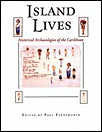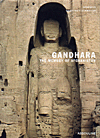

| |
| Editors' Picks | Volume 55 Number 1, January/February 2002 |
Island Lives: Historical Archaeologies of the Caribbean (Tuscaloosa: University of Alabama Press, 2001; $29.95), edited by Paul Farnsworth, collects essays by archaeologists investigating the rich legacy left by European colonists, African slaves, and their Creole descendants on the islands of the Caribbean. With pieces ranging from the archaeology of Spanish towns to Dutch sugar plantations, this volume gives an excellent overview of a burgeoning field. The studies also show how historical archaeology is playing a surprisingly significant role in the development of new national identities in the region. |

|
 |
Ignore the purple prose of the leaden, poorly-translated-from-the-French introduction of Bérénice Geoffroy-Schneiter's Gandhara: The Memory of Afghanistan (New York: Assouline Publishing, 2001; $18.95) and instead marvel at the photographs of sculpture that make up most of this slim volume. The images are so beautiful that you don't need the author's ramblings on the primary allure of Ghandaran art, which features what the translator renders as a "subtle blend of Indianity [!] and Hellenism." |
Can't afford to buy your sweetheart a pyramid this Valentine's Day? How about Miroslav Verner's The Pyramids: The Mystery, Culture, and Science of Egypt's Great Monuments (New York: Grove Press, 2001; $35.00) or Martin Isler's Sticks, Stones, & Shadows: Building the Egyptian Pyramids (Norman: University of Oklahoma Press, 2001; $29.95) instead? Verner, head of the Czech excavations at Abusir, presents an overview (chapters on origins and construction, as well as burial and mortuary cult) and comprehensive catalog of pyramids. Silly ideas--like the claim the Giza pyramids were built in 10,000 B.C. rather than around 2500 B.C.--are dismissed in an epilogue. Isler (a sculptor and president of a New York graphics firm) draws on his 30 years of studying the pyramids to develop thought-provoking solutions to questions about the mechanics of their construction. Not one to work solely on paper, Isler conducts interesting field trials, such as testing the effectiveness of lubricants--thin layers of mud and banana peels--in moving large stone blocks. |
  |
 |
Reading the Maya Glyphs (New York: Thames & Hudson, 2001; $21.95), by Michael Coe, finally makes the enigmatic Maya script accessible to the non-epigrapher. Easy-to-digest chapters with practice exercises instruct how to read glyphs of different themes, such as royal rituals, warfare, the calendar, and places and polities. Impressive illustrations, including glyphs expertly drawn by Mark Van Stone, useful discussion of
cultural and linguistic issues, and practical appendices make this
a fun and user-friendly guide for both scholars
and avocational Maya enthusiasts. |
In The Civilization of Angkor (Berkeley: University of California Press, 2001; $27.50), Charles Higham combines archaeological and literary evidence in tracing the rise and abandonment of Angkor (in A.D. 1431). Cambodia's ancient monuments at Angkor are so familiar that we can all chuckle at this comment of a Portuguese author in 1609: "I confess I hesitate to write this, it appears as fantastic as the Atlantis of Plato. Today the city is uninhabited. A learned man supposed these to be the works of Trajan." Yet few of us know much about the civilization's origins. Let Higham
fill you in. |

|
© 2002 by the Archaeological Institute of America archive.archaeology.org/0201/reviews/picks.html |
Advertisement

Advertisement






